Benin Art And Architecture - Culture (4) - Nairaland
Nairaland Forum / Nairaland / General / Culture / Benin Art And Architecture (207145 Views)
Art And Architecture Of The Igbo People / The Art And Architecture Of Yorubaland! / Show Pictures Of Africas Art And Archaeological Treasures (2) (3) (4)
(1) (2) (3) (4) (5) (6) (7) (8) (9) (10) ... (25) (Reply) (Go Down)
| Re: Benin Art And Architecture by PhysicsMHD(m): 2:07am On Feb 15, 2011 |
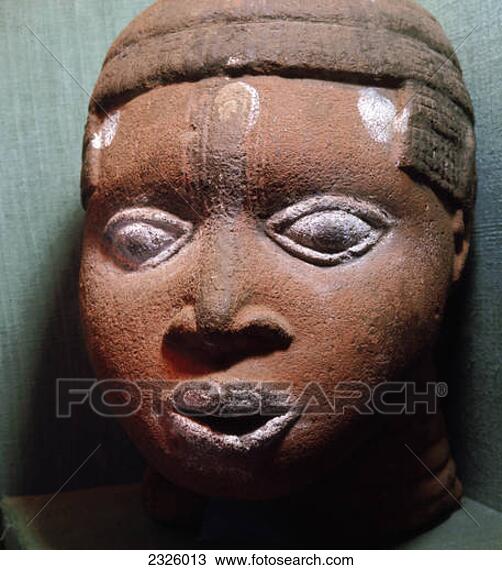 Terracotta head of a man, Benin, Nigeria, 17th century |
| Re: Benin Art And Architecture by PhysicsMHD(m): 2:07am On Feb 15, 2011 |
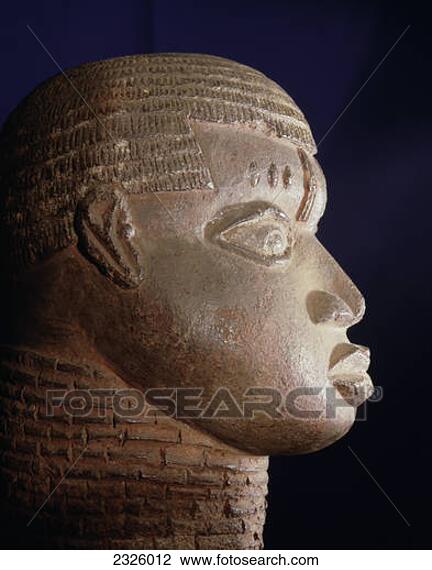 Terracotta head of a man, Benin, Nigeria, 17th century |
| Re: Benin Art And Architecture by PhysicsMHD(m): 3:13am On Feb 15, 2011 |
 Ornamental brass hip-mask, Benin, Nigeria |
| Re: Benin Art And Architecture by PhysicsMHD(m): 3:14am On Feb 15, 2011 |
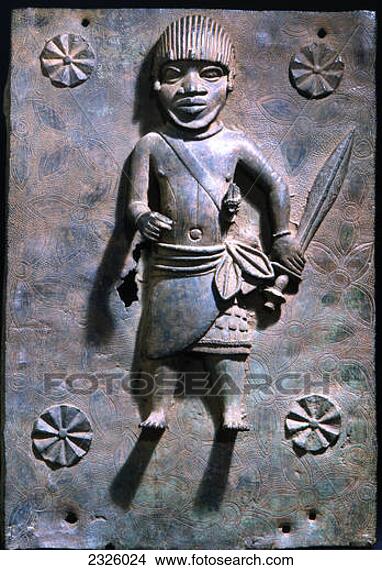 Plaque depicting a messenger, Benin, Nigeria, probably 17th century |
| Re: Benin Art And Architecture by PhysicsMHD(m): 3:15am On Feb 15, 2011 |
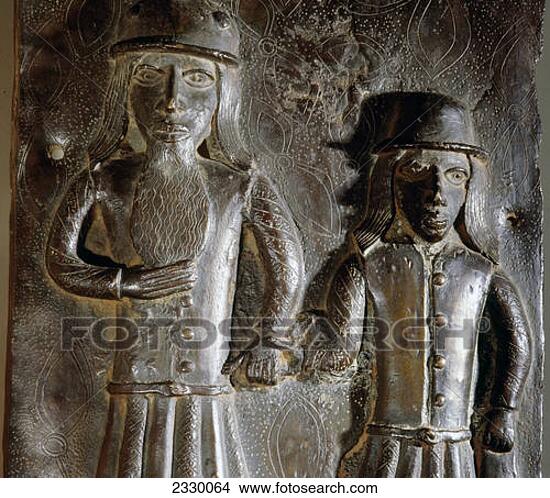 Brass plaque which decorated the palace of the Benin Obas, Benin City, Nigeria |
| Re: Benin Art And Architecture by PhysicsMHD(m): 3:16am On Feb 15, 2011 |
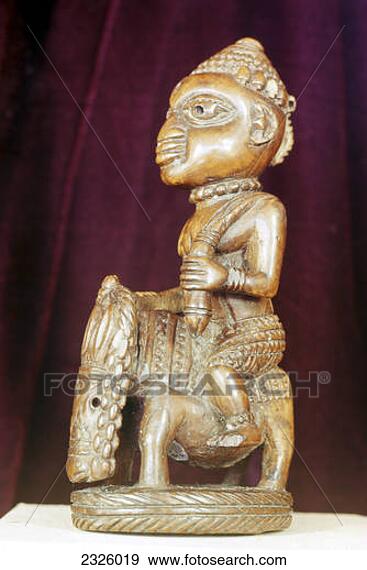 An ivory carving of a horse and rider, Benin, Nigeria, 18th century |
| Re: Benin Art And Architecture by PhysicsMHD(m): 3:17am On Feb 15, 2011 |
 Brass figure of a hornblower or trumpeter at the Benin court, Nigeria, probably 17th century |
| Re: Benin Art And Architecture by PhysicsMHD(m): 3:20am On Feb 15, 2011 |
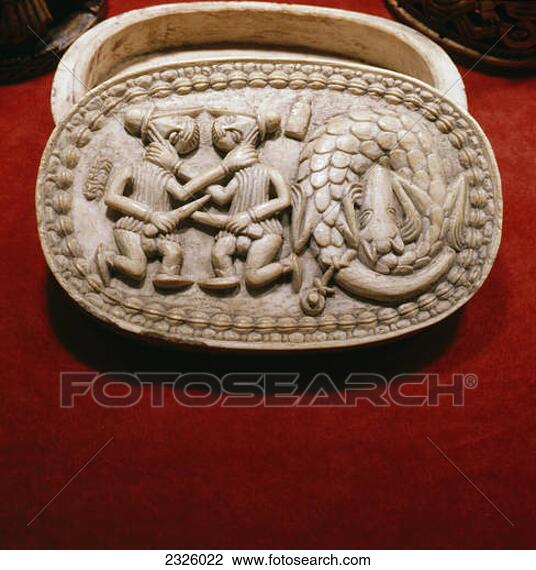 Ivory box, Benin, Nigeria, 16th-17th century |
| Re: Benin Art And Architecture by PhysicsHD: 4:36am On Feb 15, 2011 |
 A bronze Benin armlet terminating in a crocodile head, Nigeria |
| Re: Benin Art And Architecture by EzeUche2(m): 7:15am On Feb 15, 2011 |
Benin was truly great in the past. A truly authentic African empire.    |
| Re: Benin Art And Architecture by PhysicsMHD(m): 5:43pm On Mar 02, 2011 |
 Edo, Benin City, Nigeria, 15th century AD Accession Number 24.4.1899.20 This realistic head dates from the earliest period of Edo court sculpture, before European contact in the late 15th century, because bronze sculpture progressed from a naturalistic to a more formal style. It is small and finely cast because bronze was scarce. |
| Re: Benin Art And Architecture by PhysicsMHD(m): 5:49pm On Mar 02, 2011 |
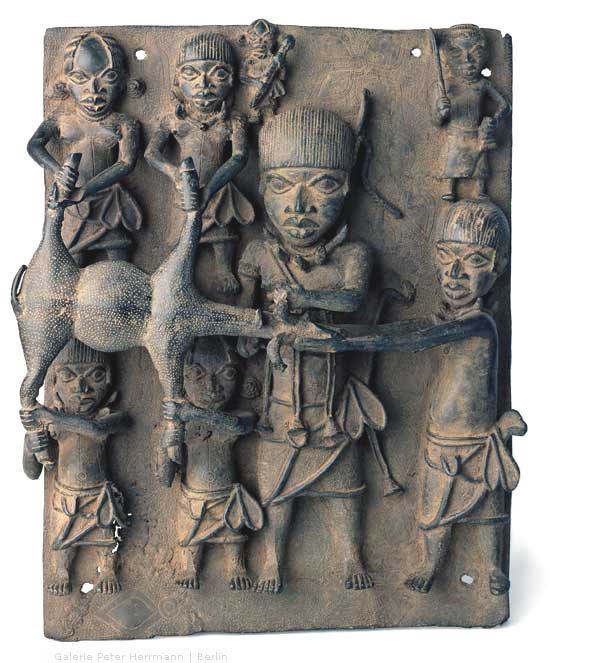 Relief Plaque with Animal Sacrifice: Ritual activities occurred in a yearly cycle at the palace, the heart of Benin; some were conducted in private for the king, others publicly for the general population. Sacrifices in which the king had a large number of animals killed were integral elements of almost all public rituals in Benin. The public slaying of cattle depicted on this relief was considered the highest form of local immolation. A large master of ceremonies draped with bells stands in the middle of this plaque and is in the process of decapitating a cow with his sickle-like knife. Five aides pull on the head and legs of the probably already dead animal, while two very small figures stand in the background, both also armed. The striking size differential amongst the figures could be an indication of their respective prominence. Accordingly, the large figure in the middle would quite clearly be the plaque's central and most important character, while the two very small figures at the top would be the lowest-ranked. Their relatively small size could, however, instead be interpreted as an attempt at perspective - already in the 17th century. This relief is a masterpiece in more than just the technical sense. A cast-bronze plaque like this one requires a quite complicated casting process, which indicates that at the time of its creation, Benin must already have had a long tradition of bronze casting. Otherwise, it would not have been possible for the slaughtered, sacrificial animal to hover in front of the plaque as it does, creating a wonderful, three-dimensional effect. Cp.: Paula Girshick BEN-AMOS: The art of Benin, London 1980, S. 70. W./ B. FORMAN, Philip DARK: Die Kunst von Benin, Prag 1960, S. 44. |
| Re: Benin Art And Architecture by PhysicsMHD(m): 5:50pm On Mar 02, 2011 |
 BENIN LOCATED IN THE HEART OF BENIN CITY,RING ROAD BENIN CITY |
| Re: Benin Art And Architecture by PhysicsMHD(m): 5:52pm On Mar 02, 2011 |
| Re: Benin Art And Architecture by PhysicsMHD(m): 5:55pm On Mar 02, 2011 |
[img]http://2.bp..com/_ALvqZc-q73k/TJeI-aS3SiI/AAAAAAAAFl8/NLPTP1kwnmA/s1600/IMG_8661.JPG[/img] Some of the magnificent 16th / 17th C bronzes from Benin City in Nigeria which were looted by the British during the so-called 'Punitive Expedition' of 1897. They are now displayed in the British Museum which resists all claims from Nigeria to return them. |
| Re: Benin Art And Architecture by PhysicsMHD(m): 6:00pm On Mar 02, 2011 |
 Benin Bronze/Brass Equestrian Sculpture - PF.4004 (LSO) Origin: Benin City, Nigeria Circa: 1725 AD to 1800 AD Dimensions: 8.75" (22.2cm) high Catalogue: V19 Collection: African Style: Benin Medium: Bronze/Brass This imposing brass sculpture of a man on horseback was made by a master metalworker of the ancient kingdom of Benin. It represents an Oba – one of the polity’s hereditary God-Kings – wearing ornate ceremonial robes drawn up to his waist, clutching the reins in his left hand and a sceptre in the other, clad further in jewellery around his neck and arms, and surmounted by a truly enormous, spiky headdress attached to the apex of a cap that covers his head down to the brows. The horse is elongated but otherwise roughly to scale, unlike Yoruba equestrian pieces in which the rider dwarfs his mount. It stands full-square, its head pointing down, and is wearing a very ornate halter and apparel, and would seem to be attired for some ceremonial occasion. The piece is darkly patinated. In the eyes of the Benin populace, the Obas were divine beings, and paraphernalia such as this was created after their demise in order to be displayed on altars dedicated to their memory. Until the late 19th century, the Benin centres were a ruling power in Nigeria, dominating trade routes and amassing enormous wealth as the military and economic leaders of their ancient empire. This changed with the appearance of British imperial forces, which coveted the wealth of the royal palaces and found a series of excuses to mount a punitive expedition against the Oba’s forces in 1897. It was only at this point, the moment of its destruction, that the true achievements of the Benin polities became apparent to western scholars. Benin royal palaces comprised a sprawling series of compounds containing accommodation, workshops and public buildings. As it grew, the buildings pertaining to previous Obas were either partially refurbished or left in favour of newer constructions; this led to a long history of royal rule written in sculptural works that rank among Africa’s finest; until European industrial advances in the 19th century, they were the finest bronzes that ever made. Metal Oba heads were used to honour the memory of a deceased king. Typically, the son of the dead king – the new Oba – would pay tribute to his father by erecting an altar in his memory. These altars were decorated with various artefacts alluding to the Oba’s achievements in life. These heads were typically arranged in pairs, each supporting an elephant’s tusk that was inserted through the hole in the top of the head. Further decorations included spears, statues, cast brass objects depicting the Oba and his followers, brass bells to awaken the spirits, rattle-staffs (ukhurhe) and magical objects that included Neolithic celts (known as “thunder stones”). The new king would pay homage to his father in this way, guaranteeing the succession and demonstrating the continuity of divine kingship. Dating these pieces is fraught with difficulty as many were taken from their context without recording of important factors and associations. Given the style, patina and signs of usage, one can tentatively assign it to the mid eighteenth to early 19th century, although it may predate this. Taken as a whole, the piece is remarkably effective, powerful and well-rendered, and would take pride of place in any serious collection of African art. - (PF.4004 (LSO)) 1 Like |
| Re: Benin Art And Architecture by PhysicsMHD(m): 6:02pm On Mar 02, 2011 |
 To the Benin, ivory was more valuable than gold and represented great kings and warriors. When used, the sounds produced by this trumpet represented the voices of the king's enemies praising him. The playing of this trumpet was also said to empower the king with the strength of the elephant it came from. On this specific trumpet we see the mother of the king seated in a place of high honor, on the very top. Below her are depictions of her servants and protectors. She herself is elegantly modeled wearing multiple strands of beads showing her high rank. Also pictured on this stunning piece is the sacred snake. It was believed by the Benin people that it was the snake that connected heaven and earth. - (PF.2876) |
| Re: Benin Art And Architecture by PhysicsMHD(m): 6:12pm On Mar 02, 2011 |
| Re: Benin Art And Architecture by PhysicsMHD(m): 6:13pm On Mar 02, 2011 |
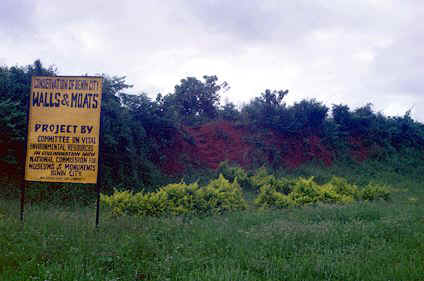 Benin City Earthworks Benin City, Edo State, Nigeria 1280 to 1460 Part of the world's largest ancient earthwork--a complex system of moats and ramparts spread over some 6,500 square kilometers--the Benin City Walls consist of a set of inner and outer interlocking rings originally built to delineate the royal precinct of the Oba, or king, from the surrounding area. Following their construction, numerous other walls were erected in the surrounding countryside to mark the agricultural boundaries around distinct settlements. Built to an original height of more than 18 meters, and a length of 1,200 kilometers, the earthworks attest the development of urbanization and rise of state societies in subsaharan Africa, a process that began in the seventh century a.d. and culminated in the founding of the Benin Kingdom of Bronze and Ivory in the fourteenth century. The Benin City Walls were ravaged by the British in 1897. Since then, portions of the walls have gradually vanished in the wake of modernization--large segments cannibalized for the construction of other buildings. However, significant stretches of the walls remain, enclosing innumerable red earth shrines and vernacular elite architecture with red-fluted walls. Though the walls and moats have been protected by national legislation since 1961, no conservation plan exists. The earthworks need to be mapped and assessed, a public awareness campaign launched, and a plan for long-term management developed. http://www.edo-nation.net/moat1.htm |
| Re: Benin Art And Architecture by PhysicsMHD(m): 6:23pm On Mar 02, 2011 |
| Re: Benin Art And Architecture by PhysicsMHD(m): 6:26pm On Mar 02, 2011 |
[img]http://academics.smcvt.edu/africanart/ashley2/Benin%20layout.jpg[/img] Benin City (Nigeria). Plan of Benin City in the nineteenth century (IV) Benin City was divided into two main sections. The inner city (Ogbe) houses first- and second- dynasty compounds along with the houses of related functionaries and the Outer city, (Ore Nokhua) houses city residents. The six mile moat surrounding the inner city was intended to prevent citizens unhappy with the king's laws from fleeing. The Royal palace, like the Asante, faced north towards Ogiwu the god of death and thunder. "The prominent cardinal positioning of the place no doubt is in reference to the king's identity with temporal and cosmological power" (IV). The palace was also placed at the intersection of the major avenues of the city. The east is linked to Osanobua, the sky god; to the west lives Olokun, god of the sea, to the south reside the health super naturals, Osun and others . Located in the village of Uselu, several miles north of the capital, is the queen mother's residence. Because she was not allowed to see her son after he became king, the two communicated by messengers. "The king undertakes nothing of importance without having sought the queen mother's counsel. The residences of other adult royal princes were also located with the queen mother's compound to pose less of a political threat to the crown. |
| Re: Benin Art And Architecture by PhysicsMHD(m): 6:34pm On Mar 02, 2011 |
 Nigeria (Benin City) - Edo Double Gong (ivory) Brooklyn Museum Double Gong (Egogo). Nigeria, Royal Court of Benin. Edo artist, early 16th century. Ivory. Brooklyn Museum |
| Re: Benin Art And Architecture by PhysicsMHD(m): 6:37pm On Mar 02, 2011 |
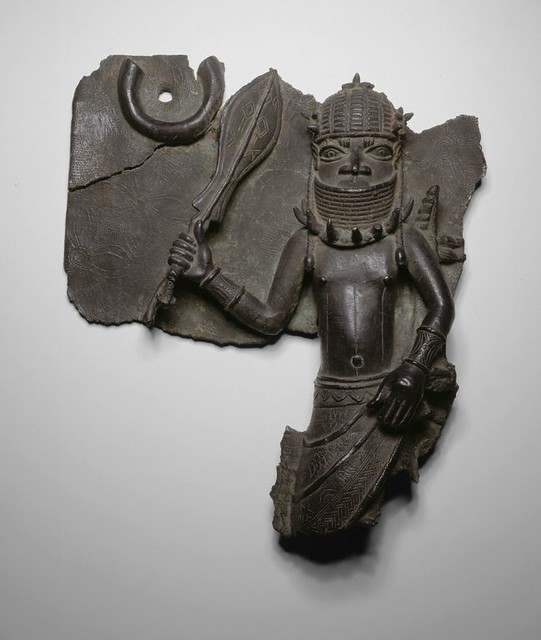 Nigeria - Edo Plaque of War Chief (Art Institute of Chicago) Nigeria Edo peoples, Court of Benin 16th/17th century Brass, 13 3/8 x 11 3/8 x 1 7/8 in. Ivory, brass and coral have long been highly valued in the Benin kingdom (established about 1300). At one time all such materials were owned by the oba, or king, who distributed them to chiefs, title holders, and other important individuals. The warrior in this brass plaque, one of many from the magnificent royal palace complex in Benin City that was destroyed by fire in 1897, wears a coral-studded cap and high coral-beaded collar, indications of his high rank. The raised horseshoe shape in the upper left corner represents a copper or brass ring, called a manilla. They were manufactured in Europe and were used as a form of currency and a source of brass for Benin royal casting. |
| Re: Benin Art And Architecture by PhysicsMHD(m): 6:40pm On Mar 02, 2011 |
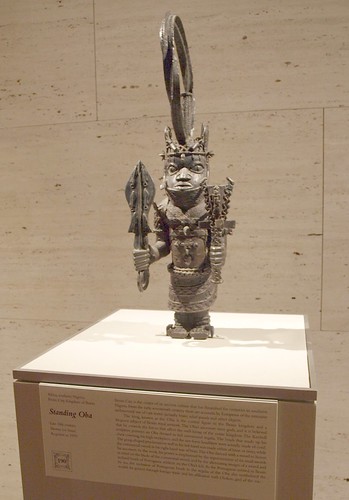 African Standing Oba late 18th century Africa, Southern Nigeria, Benin City, Kingdom of Benin Bronze (or brass) 22-5/8 x 7-1/8 x 7-3/4 in. (57.4 x 18.1 x 19.7 cm) AP 1970.04 Kimbell Art Museum in Fort Worth. Standing Oba Africa, Southern Nigeria, Benin City, Kingdom of Benin Benin City is the center of an ancient culture that has flourished for centuries in southern Nigeria. From the early seventeenth century there are accounts by Europeans of the extensive architectural use of cast metal (actually brass) relief panels and other objects. The king, known as the Oba, is the central figure in the Benin kingdom and a frequent subject of Benin royal artwork. The Oba’s ancestors were gods, and it is believed that he controls the forces that affect the well-being of the entire kingdom. The Kimbell sculpture portrays an Oba dressed in full ceremonial regalia. The beads that made up his chest covering, his high neckpiece, and the net-form headdress were actually made of coral. The gong-shaped proclamation staff in his left hand was made either of brass or ivory, while the ceremonial sword in his right hand was of brass. The Oba danced with a sword to honor his ancestors. In this work, his power is emphasized by the representation of six small swords in relief on the blade of the ceremonial sword, and by the alternating images of a sword and stylized heads of Portuguese soldiers on the Oba’s kilt. As the Portuguese arrived in Benin by sea, the inclusion of Portuguese heads in the regalia of the Oba also symbolized the wealth he gained through foreign trade and his affiliation with Olokun, god of the sea. |
| Re: Benin Art And Architecture by PhysicsMHD(m): 6:42pm On Mar 02, 2011 |
 Ivory pendant mask, Edo people, Kingdom of Benin, Nigeria. Estimate: £3,500,000-4,500,000. Photo: Sotheby's. LONDON.- On 17th February 2011, Sotheby’s will sell a rare, newly re-discovered, 16th century ivory pendant mask depicting the head of the Queen mother from the Edo peoples, Kingdom of Benin in Nigeria along with five other rare works from Benin collected at the same time. Only four other historical ivory pendant masks with related iconography of this age and quality are known – all of which are housed in major museums around the world1. All of the ivory masks are widely recognized for the quality of their craftsmanship, for the enormous scale of Benin’s artistic achievement and for their importance in the field of African art. Produced for the Oba (or King) of Benin, these ivory pendant masks are testament to the Kingdom of Benin’s golden age when the kingdom flourished economically, politically and artistically. The masks rank among the most iconic works of art to have been created in Africa. The mask to be sold at Sotheby’s in February is estimated at £3.5-4.5* million. It had been on public view in 1947 as part of a loan exhibition at the Berkeley Galleries in London entitled ‘Ancient Benin’, and then again in 1951 in ‘Traditional Sculpture from the Colonies’ at the Arts Gallery of the Imperial Institute in London. The mask and the five other Benin objects will be sold by the descendants of Lieutenant Colonel Sir Henry Lionel Gallwey (in 1913 he changed his name to Galway) who was appointed deputy commissioner and vice-consul in the newly established Oil Rivers Protectorate (later the Niger Coast Protectorate) in 1891. He remained in Nigeria until 1902 and participated in the British Government’s “Punitive Expedition” of 1897 against Benin City. The faces of the five known pendant masks have been interpreted widely by scholars of Benin art as that of Idia, the first Queen Mother of Benin. The mother of the Oba Esigie (c. 1504 – 1550), Idia was granted the title of Iyoba (Queen Mother) by Esigie in recognition of her help and counsel during his military campaigns. Idia remains a celebrated figure in Benin, known as the ‘only woman who went to war’. The masks were created at least in part as objects of veneration. The worn and honey-coloured surface of the offered mask attests to years of rubbing with palm oil, and surface as well as the style of carving is most similar to the example in The Seattle Art Museum. The mask comes to auction together with: a highly important carved tusk made with a group of other similarly carved tusks for the altar of an Oba who lived in the 18th century. The imagery presented depicts emblems of power and strength which are related to the life of the Oba himself. The iconography is specific, and can be seen repeated across many arts forms in Benin, including the well-documented bronze plaques. The collection also includes two richly carved ivory armlets which incorporate many of the panoply of motifs used by the artists of the Igbesanmwan, the Royal Guild of ivory carvers. As with most ivory carvings, these were more than likely made for an Oba, as he would have had complete control over the production of works of art made from precious ivory. Also in the collection is a rare bronze armlet, cast with Portuguese figures in an openwork motif. The earliest appearance of the Portuguese in plaques and free-standing figures and bracelets in the 16th and 17th century was undoubtedly calculated by the Benin to add considerable prestige to the Oba and his courts demonstrating that his power extended beyond the confines of his own people. Finally, the collection includes a very rare bronze sculpture of a type historically identified as tusk stands. The twisted and hollowed form of this stand suggests it served the same function as the more familiar bronze commemorative heads, as a stand for a carved ivory tusk on an altar created to honour a former ruler. *Estimates do not include buyer’s premium |
| Re: Benin Art And Architecture by PhysicsMHD(m): 6:46pm On Mar 02, 2011 |
 This powerful brass head is a representation of a queen mother (iyoba) from the Nigerian kingdom of Benin. The style of this piece is one of the earliest recorded for the Benin polity. The first major stylistic convention for such pieces was a very high, pointed headdress fitted closely around the head. The faces were typically naturalistic, and rather finely rendered. The current piece, while certainly created in this image, is likely to be made somewhat later, probably in the 19th century. The neck is tall and slender with a ringed base, running up to a rounded jawline and a slim yet robust face. The lips are sensitive yet thick, with a deft handling of the flesh of the cheeks that implies that the woman depicted as of a certain age. The nose is trilobate, with a strong central stem and distinct, rounded nostrils. The eyes have definite rims, a characteristic most clearly seen in 18th century pieces, and pupils that were once inlaid with iron. The forehead is decorated with six vertical pellets, a number which is usually reserved for the oba himself (iyobas usually had eight pellets). The high, forward pointing headdress is typical of the early period, being rendered in a gridwork relief pattern. The vast majority of Benin’s artworks are designed to honour the achievements and/or memory of the Obas, the divine rulers of the Benin polities. Until the late 19th century, the Benin centres were a ruling power in Nigeria, dominating trade routes and amassing enormous wealth as the military and economic leaders of their ancient empire. This changed with the appearance of the British forces, which coveted the wealth of the royal palaces and found a series of excuses to mount a punitive expedition against the Oba’s forces in 1897. It was only at this point, the moment of its’ destruction, that the true achievements of the Benin polities became apparent to western scholars. The palaces were a sprawling series of compounds, comprising accommodation, workshops and public buildings. As it grew, the buildings pertaining to previous Obas were either partially refurbished or left in favour of newer constructions; this led to a long history of royal rule written in sculptural works that rank among the finest that African cultures have ever produced. The technology of bronze and copper smelting, ironworking and sculpting in a range of materials that particularly included ivory was extremely refined and effective; indeed, smelting, forging and cire perdue (lost wax) metalworking methods exceeded any seen in Europe until the 19th century. Brass or bronze Oba heads were made to honour the memory of a deceased king. Typically, the son of the dead king – the new Oba – would pay tribute to his father by erecting an altar in his memory. These altars, low platforms of mud that were arrayed around the perimeter of the royal courtyards, were decorated with these heads, and with various artefacts alluding to the Oba’s achievements in life. In traditional Benin society, the queen mother (Iyoba) is also commemorated in this way, following an edict laid down by Oba Esigie in the early 16th century. The first wife of the Oba to give birth to a live male son receives this title, for in a divine kingship system she is as important as Mary is to Christians, or Amina to Muslims. Iyoba heads can be differentiated from those of Obas by the forward-pointing “chickens beak” hairstyle which forms a shape known as the “ede Iyoba”. The typological systematics of these heads are endlessly argued over. In brief, there are two major types: the thin-walled and delicate type that is usually deemed to be earlier, and the more powerfully-built, geometrical and heavier type with a mouth-high cylindrical beaded collar that is associated with Oba head grades 4-5 of Dark’s monumental typology (? 18th century). This piece has the style of the early, tall-headdress type, but with detailing more reminiscent of later periods. It is probably a reiterative work by an enterprising sculptor in the last century of Benin’s independence. This outstanding piece is in excellent condition with no flaws and no restoration, and would take pride of place in any good collection. - (FZ.246 (LSO)) |
| Re: Benin Art And Architecture by PhysicsMHD(m): 6:47pm On Mar 02, 2011 |
[img]http://72.5.117.144/fif%3Dfpx/c/CR8238-d1.fpx%26obj%3Diip,1.0%26wid%3D400%26cvt%3Djpeg[/img] |
| Re: Benin Art And Architecture by PhysicsMHD(m): 6:48pm On Mar 02, 2011 |
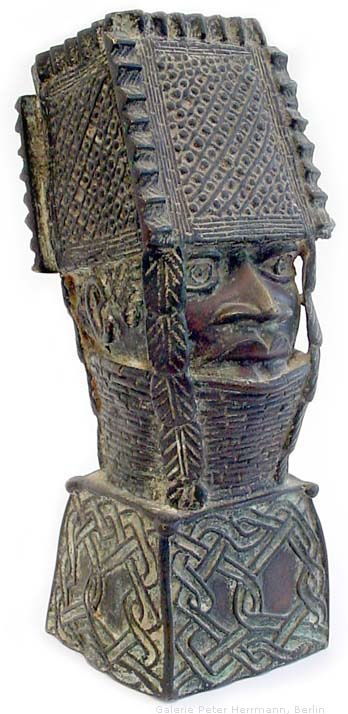 Memorial Head of General Ekeghugu Ahnekpo: This head was made in memory of a distinguished person from Ife or Benin, known as "General Ekeghugu Ahnekpo." It is the last of the memorial heads that stood in the Obaseki shrine and can be dated to the year 1884. A 2007 TL analysis indicated an age of 100 years (plus or minus 30%), confirming an estimate made in 1989. Stylistically, this head follows the model of representations of Esigie's warrior father, Oba Ozolua the Conqueror (1481-1504), a legendary figure well-known for his impenetrable iron cloak, which included a rectangular headdress like the one seen here. The facial characteristics of this head, however, are more closely related to the later, more realistic period of casting; furthermore, the head is smaller than most 16 th-century heads. |
| Re: Benin Art And Architecture by PhysicsMHD(m): 11:01pm On Mar 02, 2011 |
I've only seen this box-shaped hat in one other Benin bronze. An interesting departure from the regular styles. |
| Re: Benin Art And Architecture by ezeagu(m): 3:26am On Mar 03, 2011 |
The box hat is interesting. It looks powerful. Did Edo have any type of writing they communicated with (like to generals and the queen mother and all, giving them signs or a word)? |
| Re: Benin Art And Architecture by EzeUche2(m): 4:50pm On Mar 03, 2011 |
I'll be lying if I said I wasn't envious of the might and culture of the Benin Kingdom. |
(1) (2) (3) (4) (5) (6) (7) (8) (9) (10) ... (25) (Reply)
20 Popular Yoruba Charms And Their Uses(With Direct English Translations) / HAUSALAND: Teach Me Hausa / The Culture Lounge
(Go Up)
| Sections: politics (1) business autos (1) jobs (1) career education (1) romance computers phones travel sports fashion health religion celebs tv-movies music-radio literature webmasters programming techmarket Links: (1) (2) (3) (4) (5) (6) (7) (8) (9) (10) Nairaland - Copyright © 2005 - 2024 Oluwaseun Osewa. All rights reserved. See How To Advertise. 66 |